Okami is a game of excess. From its sumptuous hand-painted look to its litany of collectibles, every aspect of this adventure has been worked over and added to until it's bursting at the seems with originality and enthusiastic energy, but sadly also includes some redundancy and trivialities. It all starts with a simple tale: a horrible evil, named Orochi, stirs just outside a small town every 100 years and requires a civilian sacrifice to quell its desires. A hero, in this case a sun god named Amaterasu assuming the likeness of a wolf, is the only one who can restore the village to a peaceful state. From there unfurls a lengthy campaign against Orochi that spans numerous villages and an assortment of characters.
And I do stress lengthy. Okami requires over thirty hours to complete, and that's if you don't stop to gape at the wash-painted-style visuals. I spent over forty hours wading through the game and its occasionally lackluster side-quests before I completed it, and I've spent even more time on it since. The bulk of that experience was wildly refreshing and consisted of roaming through the sprawling lands, using Amaterasu's celestial brush to literally paint and reinvigorate the desiccated wilderness while fending off and suppressing the evil that's overtaken the world. Just galloping across the serene hills while watching the skies shift, twirl and tumble, all to the rich woodwind & taiko drum-peppered soundtrack sent chills through my body. No, I have no guff with the silky gameplay, the stunning graphics or even the 'motivational' story – I'm irked by some of the excess that makes the game so long.
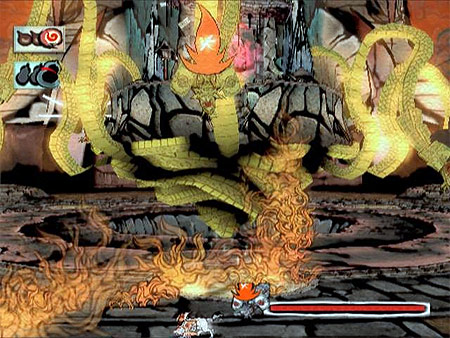
As has been discussed in prior articles, unless it's woven into the story or complements the narrative, I don't give one whit about collecting items. Predictably, given the nature of the action/adventure genre, there are plenty of items to collect in Okami, mostly frivolously so. While guiding Amaterasu through the game, you'll encounter a number of breakable pots that contain items that replenish your health, ink (for the aforementioned brush) or money. You'll also find treasure chests littering the landscape, containing some of the same pot items but also housing collectibles such as exquisite pearls, coral sculptures or stray beads. While these sort of details are standard in the genre that Okami is firmly planted in, in Okami's case they're not only almost completely unnecessary, but the sheer number of them are utterly excessive.
The collecting of these treasures and artifacts exist in-game for no thematic purpose in the game other than to line your wallet and sadly, there's already a plethora of cash (yen, specifically) available everywhere, and very little reason to spend it. Not only is money available in the pots but you also receive plenty of it after every enemy battle, so there's often ample yen in your cache to buy anything you would need. What's worse is that any purchasable items, apart from a couple of side quests that require you to purchase specific items from a store, are available 'in the wild', either from other characters, those ever-present pots or can be dug up out of the ground itself. There's a similar frivolity present through the game's weapons as well: you can receive plenty of main and secondary weapons by defeating the game's bosses so there's rarely a reason to fund a vendor to arm yourself. On top of that, it's difficult to discern the differences between many of the weapons, enough so that I often just gave up trying to figure out the positive and negative attributes of each and just equipped whichever weapon I had most recently acquired.
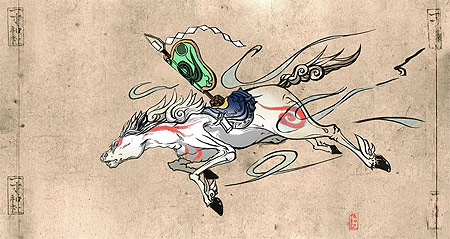
This confusion & excess severely weighs the game down. These elements feel half-heartedly throw in simply because they're genre staples. One glaring example concerns the previously mentioned 'ink bottles': while you can collect these ink bottles to refill your ink gauge, your ink gauge automatically, and quickly, refills itself over time. Often it's faster to sit and allow the gauge to replenish rather than actually run towards an available ink bottle. So why even bother with the ink bottles when, by the time you collect them, they're unnecessary?
It's an utterly superfluous and completely excessive item in the game, and I spent far too much time mindlessly smashing into pots and opening treasure chests for items like it so that I would always be prepared, so I would not miss anything necessary and hopefully lessening the impact of future in-game burdens. Unfortunately, come the end of the game, I realized I had vastly over-prepared and that at least a quarter of my game time had been wasted simply because years of playing games have pounded into my head 'if it's in a treasure chest (and it's not booby-trapped), you'll want what's in it and will need it later.'
That is not to say that all of Okami's collection-oriented excesses is lacking – quite the contrary. There's a good reason to run out and try and encounter every enemy available throughout the game, and not just for checking them off a list. Each enemy you run into is added to a massive scroll that can be viewed in the 'bestiary log'. And while being able to view individual enemy art is nothing new, the sumi-e portraiture of every character is stunning, each consisting of an amazing amount of detail and is quite a contrast from the fatter lines and less-sinister in-game art style. Lastly, rolling out the 'bestiary scroll' is a compelling experience in and of itself, weaving all of the game's characters into one sheet of continuous paper, creating a narrative tapestry of each character's introduction, nature and disposition and tying nicely into one of the game's final plot points.*
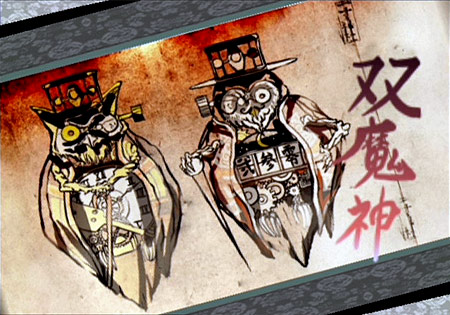
There is also the matter of the animal kingdom in Okami. You encounter a number of startlingly adorable creatures throughout the game and, if you have one of four available feedbags, you can feed them. Electing to stop and squelch each animal's hunger adds a notch to your animal log and some 'praise points', but neither of those are that important to me. It's what happens when you feed the animal that's so special: you jump to a serene, flowery field that depicts Amaterasu sitting alertly in front of the animal, watching them while they munch away at the food. You have no control over the scene (apart from pressing 'start' to skip it) and are forced to watch the camera slowly pan around the two creatures, reveling in Amaterasu's godly mothering and protective sensibilities. Does it abruptly take the game out of your hands? Yes, certainly. But, apart from story-based cut-scenes, there's no other moment – not even in the game's loading screens – when you're unable to do anything but sit and contemplate. It's a small moment, but it serves as a reminder as to Amaterasu's benevolent nature, as well as reminding the player of the peaceful world that Amaterasu is fighting for.
Amaterasu is trying to restore the game's world, to bring it back to life, and therein lies the third beneficial collection quest. One of Amaterasu's brush techniques is called 'Bloom' which, when drawn, revives wilted objects and brings out the 'good' in everything. The evil that has invaded the lands robs trees of their former luster and, as you run through the world you can rejuvenate them with the Bloom technique, causing them to blossom and bear fruit. Over time, Bloom can even change the town's overall landscape and horizon! While you gain items and points for successfully using Bloom, this action, like the animal feeding, is deeply tied into the game's themes of growth and resolve. Blooming the trees & plants also serve to please the creatures and characters that populate the world, as whenever you Bloom a tree back to life the surrounding animals and people jump and clap, vocalizing their pleasure that a small piece of their world has been restored.
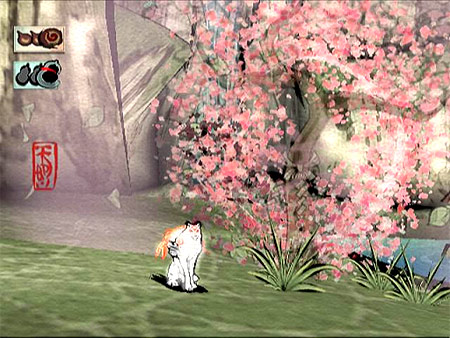
These two dualities of excess aren't unlike types of excessive meals: the character-oriented, story-based excess falls along the lines of over-indulging in an elegant French dinner, a meal of subtle and complicated tastes that leaves your stomach slightly bloated but your mind sated, thanks to the depth of flavors of the dishes. The money and item-based collections are akin to eating too many fast food fries: their flat taste is not unappealing but, while it may fill the stomach, your mind is left untouched and, before you know it, your belly is lamenting the meal.
Yes, Okami is a game of excess, but half of its excess showcase exactly what a wonderful and poignant experience the game can be. The other half is a niggling, but persistent, reminder that a bloated game doesn't always provide a richer playing experience. The item-based half come across as a causality of last-minute design changes – the ink bottle in particular. It feels like, at some point in the game's development, there was a tangible reason to collect ink bottles. Perhaps the game initially didn't have a refilling ink gauge, or painting required more ink. And for whatever reason, possibly to make the game more accessible or to (ironically) keep users from getting bogged down searching for ink bottles, they tweaked the design and rendered that portion of the game mostly useless.
Regardless of the reason and, in spite of the negative item abundance, Okami stands as a tribute to excess, and not just for the reasons detailed above. There are numerous other examples such as the not one, but two, collection games that can be played during a loading screen – two more than you'd normally receive. Every single weapon in the game has its own unique non-combat animations: one sword has a simple array of thorns that rotate up and down the blade, while a disc-weapon stunningly & perpetually breaks apart in a dozen pieces and then reforms itself. Okami is loaded, almost bloated, with these sort of extravagances and often is better for it, weaving in character nuances and making the world feel more fleshed out and alive. But when the excess doesn't add to the characters, when it doesn't showcase the story or the world design, when it just causes me to mindlessly increase quantities of items I'll never need, then I can't help but remark that not all of Okami is as rich as it could have been.
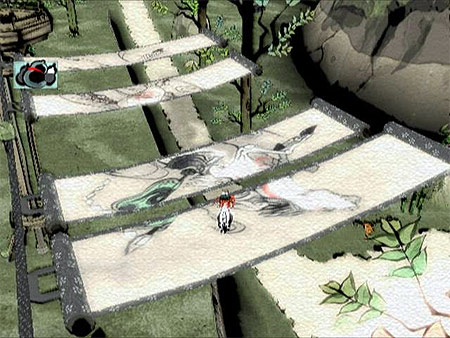
* It's worth noting that once you spend 30 hours of playtime on the game, you automatically unlock a section named 'Presents from Issun' (Issun being Amaterasu's in-game companion), which contains larger versions of the bestiary scroll artwork. Unfortunately they are presented as single images, instead of in one continuous scroll, so part of the effect is lost.




#1 w3a2 Oct 23, 2006 10:21pm
Aside from on this site, i had never heard of Okami. Your article is well written and makes me want to play it.
#2 TrueTallus Oct 24, 2006 01:29pm
Some of the later skills at the dojo are quite expensive (2,000,000 yen right now) so I've appreciated finding all the treasure I could. Maybee thats a trivial amount later in the game, (*SPOILER* I'm just about to go to the Dragon City to find out about the water dragon *END SPOILER*) but at the moment every bit helps. And once I obtained the waving cat statue, ink bottles became a useful addition. Since I no longer have to bother with going to get them, I can continue a fight or do a mass rejuvanation spree without stopping or worrying about turning into normal sucky wolf form - that super burning infinity sign technique can drain ink like nobody's business.
#3 Soup Oct 27, 2006 08:43am
collecting items reached it excess in Jak & Daxter. A "secret ending" was teased if you went out and collected all 101 precursor orbs (only 80ish needed to complete the game), but man was it a letdown. At least in this game, as in the zelda series, you can buy stuff with your extra item collecting.
#4 Max Walrus Oct 29, 2006 10:16pm
Interesting focus for the article. A worthwhile complaint.
#5 Okami_Gal Sep 24, 2007 07:52am
OMG, that sucked!! Your a moron, okami rulz!!! U suck, u jackass!!!
#6 Anonymous Oct 8, 2007 01:48pm
I agree that Okami had its weaknesses and strengths. I love Japanese artwork like that diplayed in Okami. I beleive that there were a lot of needless comments like the side story with Bamboo girl. I was so disappointed. The game started to get boring near the end. It became redundent but I was addicted so I could stop. I wish the game had picked up instead of slowing down. Also, I had hoped the ending wasn't like it was. Those that have beaten it know what I am talking about.
SPOILER!!!!!! Why did the person that is supposed to be an enemy becomes a friend. I didn't like that.
Anyways. For all it's ups and downs I thought is was great. I enjoyed the landscape and would sometime just sit at the top of a hill and look at the landscape change and the people in a town go about their lives.
#7 Anonymous Nov 10, 2007 08:09pm
Okami only takes about 16 hours to complete, whilst stopping to gaze at the surrounding artwork of the world. I did it on my first try.
#8 Anonymous Feb 17, 2008 02:51pm
I really think you are exaggerating. Come on, so ink pots and treasure are frivolous, so what? The rest of the game is great, (besides the innapropriate parts, of course) so why complain about such small, trivial things? Besides, you aren't a real gamer if you don't collect items if only for the sake of collecting them. Besides, all of the animal statues are part of a set of 13, so it is a goal the player can make for themself to collect them all. If you don't give a hoot about items, it wasn't very hard to figure out very, very early on that they weren't worth collecting. Those 'wasted' hours were your own fault. And those ink pots? It's not like they wasted any of your time. They're just part of the game. It seems to me like you're just looking for things to criticize.
#9 Bob Apr 13, 2008 02:26am
I wholeheartedly agree with your sentiment. I'm still in the process of playing right now, but it was made quite clear that the inkpots were useless outside of battles within the first couple hours.
The food is also a bit confusing because instead of getting food to sell, it credits your yen purse. Which is fine, but then why not just make them coins instead?
The weaponry not being clearly differentiated led me to choose whatever I think is prettier at the time.
There's also a problem with not being able to know for sure whether this is some quest you need to do, or the game would just like you to do.
I love the game, I really do, but those things really stick out in an otherwise wonderful experience.
I'm also very upset with the people who told me it would take 8 hours to complete. I've never played a game for this long.
#10
Hey, this article is absolutley great! I gotta say, I too was amazed at the sheer number of treasures to be found. There was a treasure chest around every turn! The ink pots, too, become less and less useful as you gain more and more inkpots.
I love the way you wrote this! I can tell that you really appreciate the work and art that went into this! I love your metaphor about the great quality meal vs. fast food french fries.
*thumbs UP* :) Thanks!
#11 Anonymous Sep 27, 2008 01:41pm
If you collect all the stray beads you become imortal! So it's NOT stupid!